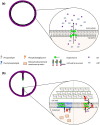Polymyxin and lipopeptide antibiotics: membrane-targeting drugs of last resort
- PMID: 35118938
- PMCID: PMC8941995
- DOI: 10.1099/mic.0.001136
Polymyxin and lipopeptide antibiotics: membrane-targeting drugs of last resort
Abstract
The polymyxin and lipopeptide classes of antibiotics are membrane-targeting drugs of last resort used to treat infections caused by multi-drug-resistant pathogens. Despite similar structures, these two antibiotic classes have distinct modes of action and clinical uses. The polymyxins target lipopolysaccharide in the membranes of most Gram-negative species and are often used to treat infections caused by carbapenem-resistant species such as Escherichia coli, Acinetobacter baumannii and Pseudomonas aeruginosa. By contrast, the lipopeptide daptomycin requires membrane phosphatidylglycerol for activity and is only used to treat infections caused by drug-resistant Gram-positive bacteria such as methicillin-resistant Staphylococcus aureus and vancomycin-resistant enterococci. However, despite having distinct targets, both antibiotic classes cause membrane disruption, are potently bactericidal in vitro and share similarities in resistance mechanisms. Furthermore, there are concerns about the efficacy of these antibiotics, and there is increasing interest in using both polymyxins and daptomycin in combination therapies to improve patient outcomes. In this review article, we will explore what is known about these distinct but structurally similar classes of antibiotics, discuss recent advances in the field and highlight remaining gaps in our knowledge.
Keywords: antibiotic; colistin; daptomycin; lipopeptide; polymyxin; resistance.
Conflict of interest statement
The authors declare that there are no conflicts of interest.
Figures





References
-
- Xu P, Zeng H, Zhou M, Ouyang J, Chen B, et al. Successful management of a complicated clinical crisis: A patient with left-sided endocarditis and secondary hemophagocytic lymphohistiocytosis: a rare case report and literature review. Medicine (Baltimore) 2017;96:e9451. doi: 10.1097/MD.0000000000009451. - DOI - PMC - PubMed
-
- Byren I, Rege S, Campanaro E, Yankelev S, Anastasiou D, et al. Randomized controlled trial of the safety and efficacy of daptomycin versus standard-of-care therapy for management of patients with osteomyelitis associated with prosthetic devices undergoing two-stage revision arthroplasty. Antimicrob Agents Chemother. 2012;56:5626–5632. doi: 10.1128/AAC.00038-12. - DOI - PMC - PubMed
Publication types
MeSH terms
Substances
Grants and funding
LinkOut - more resources
Full Text Sources
Medical

